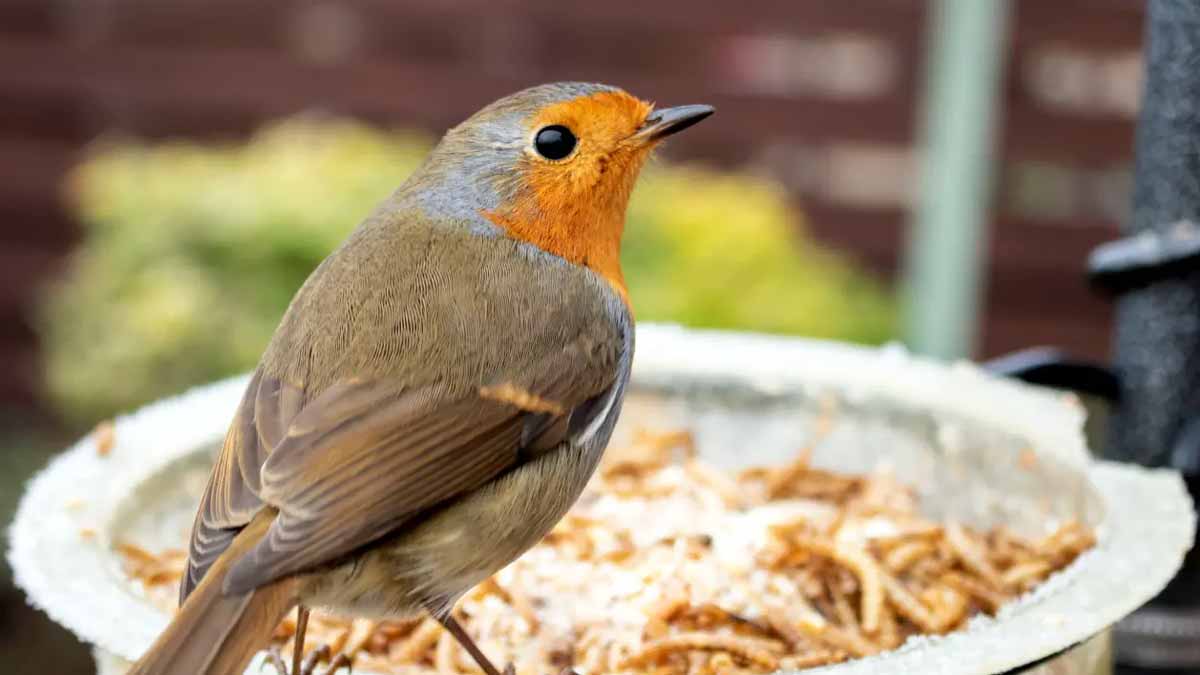A flash of red at arm’s length always feels like a small win. When robins sense safety and steady food, they settle fast and return often. Give them the right setup and your quiet border turns lively, day after day. Keep the focus simple, the space clean, and the routine predictable, because consistency builds trust and brings song back to the path.
Why robins feed best at ground level
Ground-feeding suits their watchful style, so a low tray or a bare patch works. Place seed where sightlines stay open and escape routes are clear. Blackbirds, collared doves, thrushes, and dunnocks share this habit, which means a single station can serve mixed visitors while still keeping your shy star close by.
They are red-breasted, bold, and fiercely territorial, singing through winter and spring. The species Erithacus rubecula holds small spaces like tiny guardians. Because they defend feeding spots, one reliable place reduces conflict and keeps flights short. Short hops burn less energy and, in turn, increase the time they spend foraging near you.
Low sites also reduce spillage from high tables and limit messy fall. Use a ground tray with a lip and fine mesh, which lets rain drain away. Because damp seed clumps, a dry base helps keep beaks busy, not fussy. One stable point becomes familiar, and familiarity builds a lasting loop.
Setting safe ground stations and choosing the spot
Pick an open, slightly raised corner, midway between cover and open lawn. Cats dislike crossings without concealment, so a clear approach helps birds relax. Set the tray two strides from dense shrubs, close enough for a quick bolt, yet far enough that ambush is hard. In busy yards, visibility beats shade.
Keep the station clean, because old food spreads disease fast. Every few days, tip leftovers into the compost and brush the mesh. Once a week, wash with mild, pet-safe disinfectant, then dry thoroughly. As hygiene improves, robins stay longer, since good routines lower risk. Clean seed smells fresher and clumps less.
Feed through the year, since needs change with the season. In spring, soft options matter for chicks; in summer, smaller portions waste less. Autumn calls for energy-dense bites before cold sets in; winter calls for fat-rich support. Because food availability shifts, steady supply keeps your regulars loyal and calm.
Food that robins trust and how to serve it
Start with balanced seed mixes for breadth, because variety brings more beaks. Blends scatter sunflower hearts, millet, and oats so each visitor finds a fit. Husk-free mixes reduce mess and help species that cannot crack shells, like blackbirds. Add small amounts to a ground tray, refresh often, and watch the pace.
Suet blocks, balls, and pellets add vital energy in cold snaps. Fat keeps core warmth stable while short daylight tightens feeding windows. Stir in a few dried mealworms for protein when chicks demand more. Because robins take small mouthfuls, crumble large pieces by hand. Serve modest portions and top up as needed.
Use supporting feeders to widen appeal without crowding the tray. Hanging seed feeders draw tits, goldfinches, house sparrows, greenfinches, and siskins. Fine-port nyjer feeders suit tiny seeds loved by goldfinches, siskins, and redpolls. Mesh peanut feeders prevent choking by limiting beakful size, which protects starlings and tits while sparrows still enjoy steady access.
Three feeder styles and three staple foods explained
Three service routes cover most gardens: hanging seed tubes, nyjer feeders, and mesh peanut baskets. Tubes handle blends and sunflower hearts for an all-round pull. Nyjer models grip tiny seed to cut waste in wind. Mesh peanuts stop large lumps, so small birds take safe nibbles and avoid risky gulps.
Three main food lines fit most seasons: standard seed mixes, husk-free mixes, and suet. Standard blends attract the widest cast; husk-free options cut cleanup and help soft-bill birds. Suet arrives as blocks, balls, or pellets and powers winter flights. According to the Wildlife Trust, regular supply keeps visits frequent and calm.
Match hardware and food to the station so traffic flows well. Keep the ground tray for your focal guests, including robins, while feeders run nearby. This spreads pressure and lowers spats at peak times. Short perches near tubes help small birds land cleanly. Because clutter confuses, tidy spacing keeps lines smooth.
Shelter, water, and habits that keep visits growing
Add cover that moves, not cover that hides predators. Loose shrubs and a light hedge give perches without dark ambush points. An open fence with climbers works better than a dense wall. Because wind saps heat, place your station where hedges take the sting, while a clear view still protects wary eyes.
Water multiplies visits, even in wet months. A shallow dish with sloped sides lets small birds sip and bathe. Refresh it daily and scrub twice a week to stop algae. Because slick bowls cause slips, roughen the base lightly. Keep the bath within sight of the tray so routines feel natural.
Hold the same timetable, because memory anchors flight paths. Morning top-ups suit early movement; a small late fill steadies afternoons. Avoid pesticides around the station, and leave a little leaf litter for insects. As habits settle, robins learn the beat and arrive on cue. Quiet care, not gadgets, does the heavy lifting.
A steady pattern that turns quick visits into daily company
When one ground point stays clean, visible, and well-stocked, flights feel low-risk and worthwhile. Keep portions small and fresh, rotate suet and seed with the weather, and hold your spacing. As confidence grows, robins return more often and stay longer, then claim your patch with song. Small choices, repeated, create a living border.
